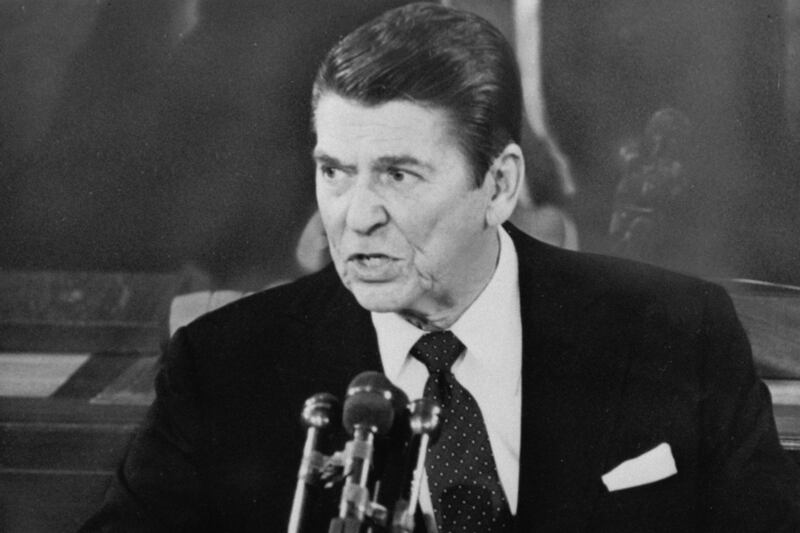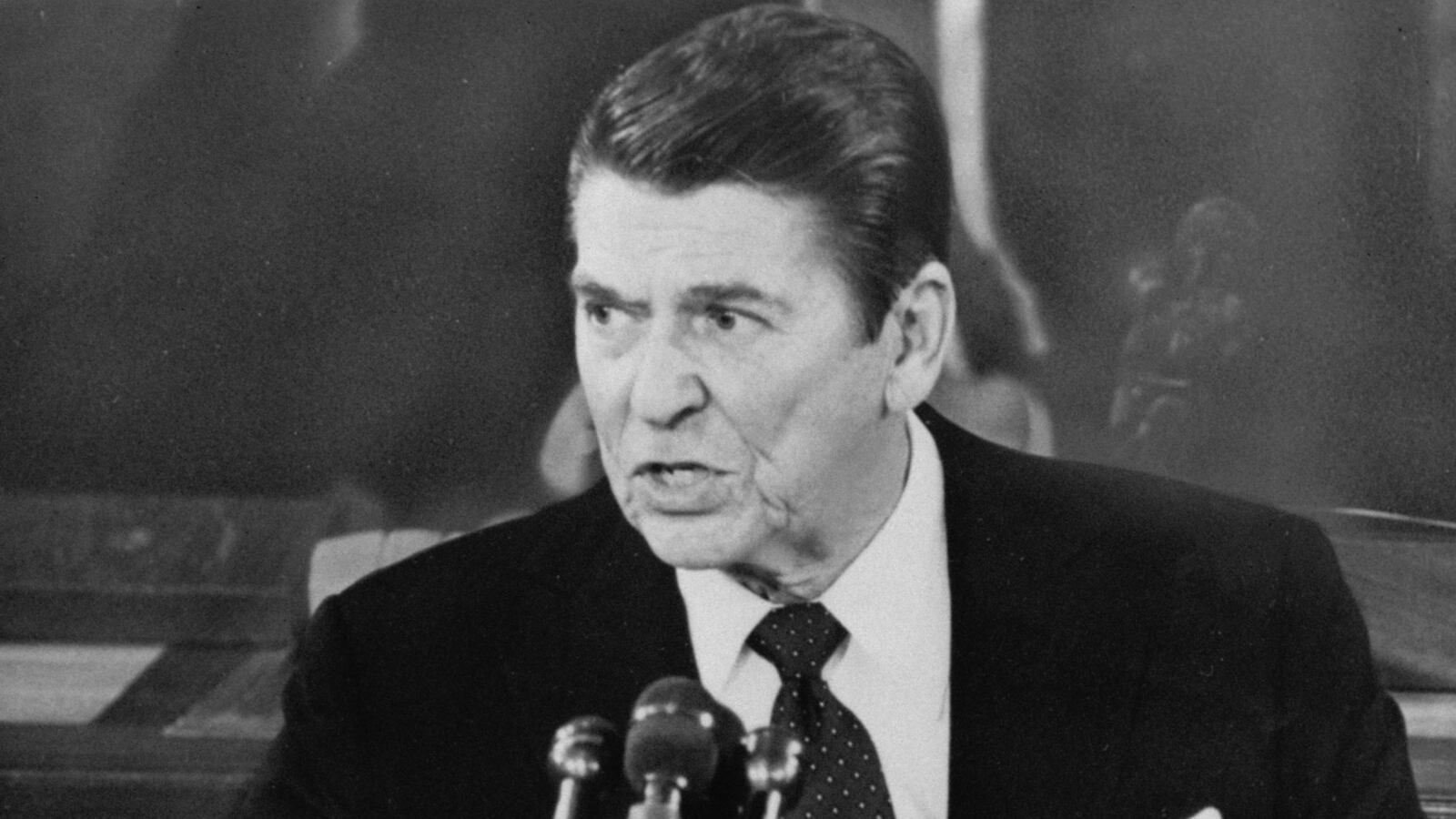The White House has now proposed a plan to raise taxes immediately and work out spending cuts in the near future. Republicans are rejecting this, calling it insulting and, in Mitch McConnell’s words, “a step backward.” In defense of their position they cite Ronald Reagan’s experience, claiming that he once made a deal with Democrats for $3 in spending cuts in return for $1 in tax increases. The Democrats got the taxes, they say, but Reagan never got the cuts. Republicans—and Grover Norquist in particular—have repeated this so often and so insistently that even Democrats seem to have accepted it as truth. The only problem? It’s a myth.

Here are the facts, complete with context:
In August 1981 Republicans controlled the Senate and had enough power in the nominally Democratic House to pass Reagan's enormous tax cuts. (Southern Democrats occupying soon-to-become Republican seats gave Reagan working control of the House and voted for the cuts. In fact, Phil Gramm was the then-Democratic sponsor of the tax-cut bill in the House. He switched parties soon thereafter and became one of the most conservative Republicans in Congress.) Despite the tax cuts, a recession started in July 1981. Reagan did inherit the so-called stagflation of high inflation and slow growth, and there was a brief recession in the first half of 1980. But the economy was growing when he came into office.
The deficit promptly soared—indeed, the national debt would ultimately triple in Reagan’s eight years in office But the economy tanked and unemployment headed toward double digits. In early 1982, concerned by this exploding deficit and convinced that the tax cuts had gone too far, Congress on a bipartisan basis moved to limit the damage. Despite outcries on the right that one could not raise taxes in a recession, advocates said that bringing down the deficit was more important.
In August 1982, the unemployment rate hit 10.1 percent, while mortgage rates hovered near their all-time high at 15 percent. Reagan's tax cuts had had a year to stimulate the economy, but they had not done so.
So Republicans in Congress and some members of his own administration convinced Reagan to agree to a $98.3 billion tax increase, the largest peacetime increase in history. Despite current Republican claims, however, Congress did not make a “deal” to cut $3 in spending for every $1 in tax increases, although—to quiet criticism from the right—the White House began saying that there was. As Bob Dole told then–house budget chair Bill Gray, there was a deal but it was between Reagan and his speechwriters.
The agreement was in fact supposed to bring total spending down by $284 billion. But less than half of this amount involved cuts in appropriations or entitlements, or for that matter any congressional action at all. The Reagan administration promised to cut $47 billion in spending through "management savings" by cutting everyone's favorite target: waste, fraud, and abuse. No savings in this area ever materialized. (This was another “magic asterisk” from OMB Director David Stockman, much like the famous “savings to be identified later” in his first budget.) In addition, $108 billion was to come from lower interest payments, since interest rates were projected to fall. That left about $130 billion in appropriation cuts for Congress to make.
Of this, roughly half the reductions were to come from defense spending. Defense Secretary Caspar Weinberger convinced Reagan to renege on his support for these cuts, so they never happened. Of the nondefense appropriations, Congress actually did deliver on roughly three quarters of them, including close to $30 billion in Medicare savings.
Stockman recalled it a big differently in his 1986 book, The Triumph of Politics: Why the Reagan Revolution Failed. “Of the spending cuts Congress allegedly owed, $100 billion consisted of savings in debt service that Congress couldn’t do anything about; $40 billion was management savings that we had promised to come up with, and hadn’t; another $30 billion had actually been delivered in Medicare reimbursement reforms and other measures. Most of the remainder was the $50 billion in three-year defense cuts Howard Baker was proposing to cut again—and which Weinberger was refusing to cut again.”
So the Reagan administration failed to deliver on more than $110 billion of cuts it had promised. On nondefense spending, Congress delivered most of what it had committed to, including in Medicare. The actual ratio between tax increases and spending cuts, which Reagan accepted, came out closer to 1-to-1. Failure to do more was entirely the responsibility of the Reagan administration.
And what happened in the real world while Washington worked on the problem? On Aug. 17, 1982, while a House-Senate conference committee was working out final details with White House support, and it became clear that the tax bill would become law, the Dow Jones industrial average responded with its single biggest one-day leap ever—a 4.9 percent gain, the equivalent of a 600 point gain today. (The actual gain was 38.81 points, pushing the Dow Jones above the 800 mark to 831.24. And it marked the beginning of the bull market.
Reagan signed the tax increase on Sept. 3, 1982. A few months later the economy roared to life as well.
In sum, the claim that Democrats never delivered on promised cuts is pure myth. The cuts Reagan promised (and that the Democrats agreed to) were in large measure illusory. Also, the economy did not initially respond to the Reagan tax cuts. It came to life only after a major tax increase. These facts are indisputable. This is not to say the tax cuts played no role in economic growth. Instead, it highlights a truth that is obvious but bears repeating: the linkage between tax policy and growth is far more complex than Republicans care to admit.
Of course, someone as well versed in these issues as Norquist knows what really happened. But Norquist is a propagandist, and isn’t one to let the accurate historical record get in the way of a good talking point. Making policy is difficult enough when the facts are agreed upon. It becomes impossible when one side argues mythology instead of reality.





